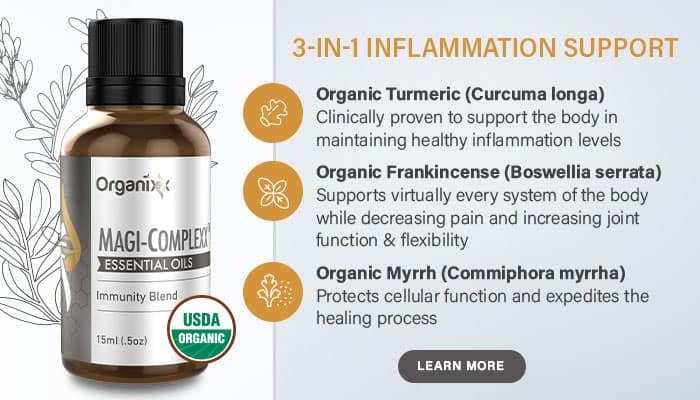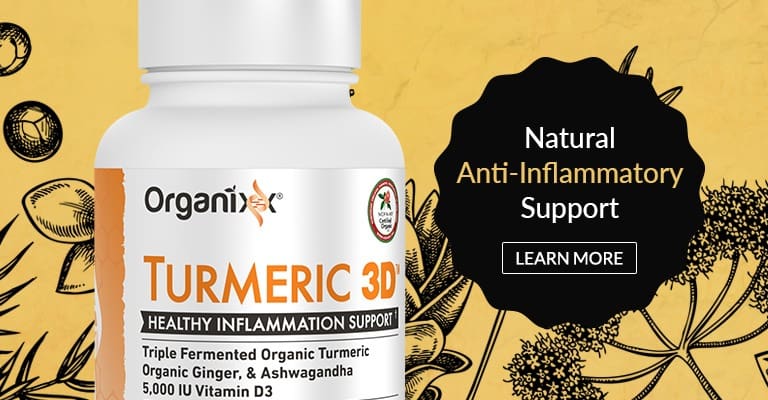Forgiveness. It seems a simple concept, but for some, forgiving a person who has done them wrong can be challenging because it requires potential confrontation and demands courage. Yet there are many reasons to consider forgiving those who have hurt us.
This article will share powerful reasons for practicing forgiveness, along with tips on how to forgive to help guide you through the process.
Why Should We Forgive?
The sense of peace and spiritual well-being that comes from forgiving another can be quite powerful. Letting go of old wounds can be liberating, transformative, and healing – both for ourselves and for the person we forgive.
Holding onto resentment and repressing anger can have some wide-ranging negative effects on our physical, spiritual, mental, and relational well-being. And the person most hurt by this anger and resentment? The one holding the grudge.
According to author Gerald Jampolsky:
“Forgiveness is an inner correction that lightens the heart. It is for our peace of mind first. Being at peace, we will now have peace to give to others, and this is the most permanent and valuable gift we can possibly give.”
Our spiritual teachers have much to tell us about how to forgive. In the Christian Bible there are many passages which discuss forgiveness. One of the most famous comes from Matthew 18:21-22, in the parable of the unmerciful servant:
Then Peter came to Jesus and asked, ‘Lord, how many times shall I forgive my brother or sister who sins against me? Up to seven times?’ Jesus responded, ‘I tell you, not seven times, but seventy-seven times.’
Why Forgiving Another Is So Difficult
 Often the hardest part of the forgiveness process is understanding why we should do it in the first place. While we may believe that we should forgive, it can be a step that is exceptionally difficult, and requires us to dig deep. That can be painful, so we resist it.
Often the hardest part of the forgiveness process is understanding why we should do it in the first place. While we may believe that we should forgive, it can be a step that is exceptionally difficult, and requires us to dig deep. That can be painful, so we resist it.
One reason for this resistance is that our brains are wired to protect us. We tend to hold on to resentment, mental anguish, and trauma because we need to be able to remember threats to our safety and well-being.
However, when we live in a state of unforgiveness, we hold that negative energy in our bodies and it can create havoc. This body-mind connection was commonly accepted centuries ago. King Solomon is credited with saying “Eliminate anger from your heart and remove harm from your flesh.”
This references the notion that harboring resentment is detrimental to the body as well as the spirit. It turns out this is more than a notion – it has been confirmed by a number of studies.
Science Shows Unforgiving Attitudes Can Lead to Poor Health
Thousands of studies have been conducted on forgiveness. It is actually one of the hottest fields of research in clinical psychology.
Everett Worthington Jr., a clinical psychologist and researcher who has spent the better part of two decades of his career studying forgiveness, says that forgiveness is not about forgetting or pardoning an offense. It’s about replacing negative feelings with feelings of care and compassion and a genuine desire for reconciliation. He has also advised,
“…every time you feel unforgiveness, you are more likely to develop a health problem.”
Worthington says there’s good reason for adopting a forgiving attitude and making it a way of life. Describing a study he conducted to determine whether people’s stress levels were related to their ability to forgive a romantic partner, he states:
“We measured levels of cortisol in the saliva of 39 people who rated their relationship as either terrific or terrible. Cortisol is a hormone that metabolizes fat for quick response to stress (and after the stress ends, deposits the fat back where it is easily accessible – around the waist).
People with poor (or recently failed) relationships tended to have higher baseline levels of cortisol, and they also scored worse on a test that measures their general willingness to forgive. When they were asked to think about their relationship, they had more cortisol reactivity – that is, their stress hormone jumped. Those jumps in stress were highly correlated with their unforgiving attitudes toward their partner.
People with very happy relationships were not without stresses and strains between them. But forgiving their partner’s faults seemed to keep their physical stress in the normal range [1].”
Holding in Anger Also Harms Your Health
Other studies have shown that chronically-suppressed anger compromises health, resulting in elevated heart rate and blood pressure, and an impaired immune system.
One study investigated the physical responses resulting from study subjects thinking about someone who had mistreated, hurt, or offended them. While the subjects thought about these transgressions, their heart rate, blood pressure, sweat gland activity, and facial muscle tension were monitored.
Not surprisingly, when study subjects thought about these old offenses, their heart rate and blood pressure soared, and they sweat more. They described feeling sad, angry, anxious, stressed, and less in control. When the subjects were asked to try to empathize with their offenders or imagine forgiving them, those symptoms of physical arousal diminished significantly [2].
A small 2014 clinical study investigated the efficacy of adopting a forgiving attitude. The study subjects were women diagnosed with fibromyalgia and who were abused in childhood by their biological parents. Researchers found that for these subjects the forgiveness intervention was helpful for improving overall fibromyalgia symptoms, and in decreasing levels of anger [3].

Rewiring Your Brain for Forgiveness
We experience heightened states of stress when recalling the details of old grudges because the brain cannot tell the difference between a real or recalled event. It reacts to all these negative thoughts as if they were happening to us now.
This starts a cycle of stress, which is like dumping toxins into our bodies. It drains us of energy, it poisons the mind, it undermines the immune system, and it poisons other relationships.
Brain research shows that when a thought pattern or behavior is reinforced, the brain quickly adapts by building and deepening neural pathways to support this.
If a person is constantly reinforcing feelings of anger, bitterness, and/or thoughts of revenge, the neural pathways for that pattern of thinking will strengthen. This makes a person predisposed to be even more angry and bitter.
But the good news is… all of this can be undone. Don’t let anger become a way of life. By adopting a forgiving attitude, more compassionate thoughts, and opening the mind to love and healing, neurons in the brain begin rewiring for this new way of thinking. The more frequently this more positive frame of mind is exercised, the stronger the pathways become.
Here is the important take-away: The brain dismantles the pathway that is not used as frequently in favor of reinforcing the one that is. It’s up to us to decide which we would like to strengthen.
Being free of resentment and grudges improves health, decreases stress, and improves our chances for happiness. All the energy that was being used to keep resentment and anger alive is released and becomes available for more positive things.
Author Isabelle Holland has this to say about unforgiveness:
“As long as you don’t forgive, who and whatever it is will occupy rent-free space in your mind.”
7 Tips on How to Forgive
There are 7 stages to cultivating a mind more wired for forgiveness than grudges. Each person may experience this differently, but this is a general guide for the forgiveness process.
#1: Make a Commitment to Reconcile
Once you have decided you wish to forgive, make the commitment to do just that. Forgiving does not mean we have to like the person we are forgiving. We do not have to be their friend or see them again.
Forgiving a wrongdoer also does not mean that we free them from the societal consequences of what they did wrong. Forgiving means that we free the offender and ourselves from the negative energy held between us.
#2: Take Time to Recall the Event
Think about the other person’s actions, how you reacted to them, and how they made you feel. Get in touch with your feelings since the event and how they may be coloring the person you are now.
#3: Develop Compassion and Empathy
We rarely know everything going on in the lives of others. Do your best to cultivate feelings of empathy for the transgressor. Put yourself in their shoes for a few minutes. See if you can get to a place where you understand that no one is perfect, that we all make mistakes.
#4: Forgive Others
You can take several courses of action here, or just one. You can write a letter. You can create a little ceremony with only you in attendance where you genuinely and deeply forgive the person. You can keep a forgiveness journal or even write a book. You can pay a visit and forgive in person.

Whatever you choose, make it meaningful to you so that healing can begin. Give it some thought; only you can decide what is right for you in each circumstance.
#5: Let Go of Expectations
If you acknowledge that you have forgiven someone, don’t expect an apology that may never come. Let go of any expectations and forgive because you are ready to do so.
#6: Forgive Yourself
It’s important that you include yourself in the act of forgiving. We often blame ourselves even more than others when something negative or traumatic occurs. If you feel you did something wrong, acknowledge it and then let it go.
#7: If Necessary, Seek Professional Help
Once you have decided to forgive someone, it may be necessary to get some professional help, particularly if the event was traumatic. If recall causes you to lose sleep, have recurrent negative thoughts, or does not ease after following these tips, be sure to seek professional counseling to help you through any difficult period.
Pastor, author, and filmmaker T.D. Jakes has this to say about forgiveness: “Unforgiveness, unchecked, becomes a cancer in our soul.” In an interview with Oprah, Jakes stated:
“If you are going to spend all that energy energizing where you’ve been, then you are not going to have the fuel and the fire and the tenacity and the aggressiveness that you need to energize where you are going. It takes more strength to forgive than it does to be vengeful and angry. Forgiveness is the gift you give yourself.”
The Navajo people of the American southwest have an old saying: “When you point a finger at someone, there are three fingers pointing back at you.”
The meaning of this saying will differ wildly between people, depending upon their background and beliefs. One possible interpretation is that whatever we send out in the world is also visited upon us with more intensity.
For instance, when pointing the finger at another, although we may not necessarily be to blame for any wrong that has been done to us, did we hold a grudge, refuse to forgive the wrongdoer, or hold another to a higher set of standards than we hold for ourselves?
Something to consider as you ponder what painful experiences from your past that you’re still holding on to. Is it finally time to forgive and let these emotional burdens go once and for all?
Magnesium deficiency is linked to stress, diabetes, heart disease, osteoporosis, chronic fatigue syndrome, depression, anxiety, trouble sleeping, sore muscles, migraines, and many more debilitating health conditions.
If your body needs magnesium, you want the most beneficial kind your body can actually absorb. Organixx Magnesium 7 gives you seven (7) of the very best, most bioavailable types of elemental magnesium available.
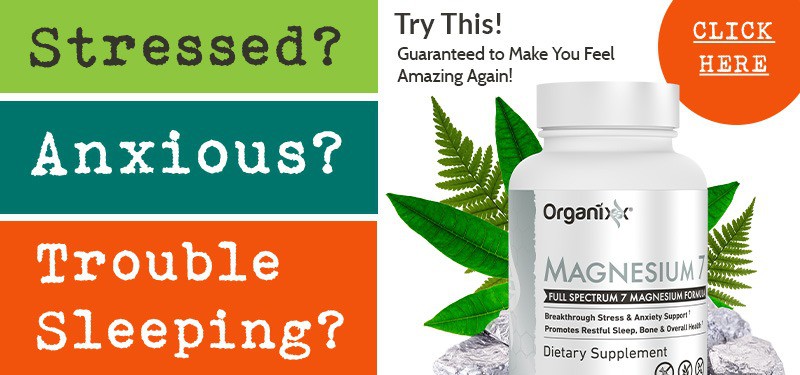
Do you have trouble getting (and staying asleep) at night? Outside of more complex sleeping disorders, there are 10 major reasons why most people have trouble sleeping. Do any of these apply to you?
10 Reasons You Might Have Trouble Sleeping
Here are some of the major sleep robbers, along with come helpful solutions to solve these particular issues.
#1: Noise
Whether it’s coming from the neighborhood, a snoring partner, crying children, barking dogs, or screaming ambulances, noise can be a big impediment to sleep.
Solution: Noise Reduction.
Depending on the situation, try these things:
- Earplugs
- Turning on a fan in the room or other “white noise” generator (but not too close to the bed, due to the EMF factor – more on that below)
- If a snoring partner is the problem, one of you should move to another room to sleep if possible. (While this is not the best solution for romance, sleep is too important to your health to ignore.)
#2: Light
Too much light entering the bedroom causes a problem because it interferes with the body’s production of melatonin (the hormone that regulates circadian sleep cycles). A 2015 study found that light pollution was associated with a higher rate of breast cancer [1].
Solution: Light Reduction.
Make your bedroom as dark as possible. This is truly important because if your bedroom contains too much light – including that little light from an LED alarm clock or cell phone charger – it directly inhibits the production of melatonin.
Use room-darkening shades (if possible) and rid your bedroom of as many appliances as you can that create little lights at night, no matter how small. Alternatively, you can wear a comfortable eye mask.
 #3: Pets
#3: Pets
Needy pets sleeping on your head do not help you achieve good quality sleep. Pets can disturb sleep by wanting to play at inconvenient hours, or wanting attention.
Solution: Get Pets Out of the Bedroom.
This may be more difficult for some pet owners (and the pets!) than for others. If you are frequently awoken by your playful pet, getting pets out of the bedroom can greatly assist you in getting a restful night’s sleep.
#4: Alcohol
Contrary to popular belief, alcohol does not help one sleep better. One study demonstrated that alcohol decreases the duration of sleep and its efficiency [2].
Solution: Limit Alcohol Intake.
If you’re someone who has trouble sleeping, it’s best to avoid drinking alcohol.
#5: Caffeine and Sugar
Both caffeine and sugar can keep you from resting well. Although how caffeine affects each person varies widely, be aware of how it affects you as an individual. Like sugar, it is a stimulant to the nervous system.
Solution: Limit Caffeine and Sugar.
Try limiting caffeine and sugar after about 3:00pm for a couple of weeks and see if it makes a difference for you.
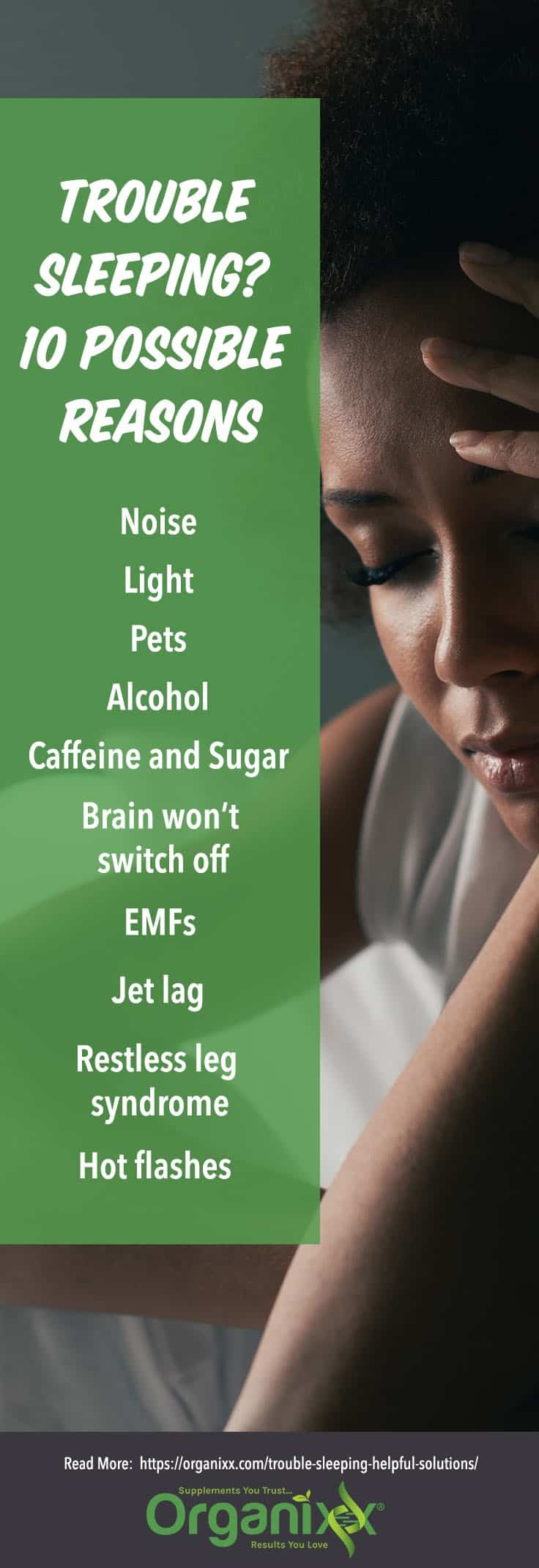
#6: Brain Won’t Switch Off.
An inability to quiet the mind or stop yourself from worrying or feeling anxious hugely impacts restful sleep. Overthinking and anxiety are in plague proportions, and we are all prone to this at times.
Solutions:
- Avoid Using Some Electronics Prior to Sleep. Try not to work in bed. Use the bed for sleeping. Do not spend long periods of time on your cell phone, laptop, or other electronic devices an hour or two prior to sleeping as they emit blue light and turn off melatonin production.Even some e-readers emit blue light. If using an e-reader, find out whether yours is safe for bedroom use or not.
- Meditation. Try meditation for 20-30 minutes prior to going to bed. Meditation can help you to shut off the overactivity in your brain by slowing your brain waves.For anxiety, positive affirmations can help. If you find your brain is running amok or you are recounting your day and all the things you could have done differently, it can keep you from sleeping.As soon as you catch yourself doing this, stop and ask yourself: “Am I okay right this minute?” If you have a roof over your head, a belly that’s been fed, and you are safe, you are doing better than 50% of the world’s population, so most of the time the answer will be “yes.”Say to yourself, “I am okay right now and right now is all that matters. This is my time for sleeping, not worrying.” This can often help your brain to “shut off.”
- Progressive Relaxation. Practice a relaxation and deep breathing technique which helps to relieve muscle tension and induce a quiet mind. Essentially, take a deep breath and let it go. Tense your feet as much as possible and then let them relax completely. Moving up your body, breathe deeply, then tense and relax various muscle groups until you reach your head.
#7: Electromagnetic Frequencies (EMFs).
Unseen, unheard, but present in most bedrooms, EMFs are caused by computers, WiFi, electric blankets and heating pads, electric appliances, alarm clocks, mobile phones and chargers, etc.
Solution: Remove EMFs from the bedroom:
- Go to an electronics supply store and buy an inexpensive multimeter and use it to test for EMFs in your bedroom. Test everything that is plugged in.
- When using a laptop computer, get a grounding pad and never use the laptop computer on your lap or in the bed.
- Remove all non-essential electric appliances from the bedroom, especially computers with WiFi. If you cannot remove them, unplug them from the wall before you go to bed. Turning them off is not enough as they still emit EMFs.
- Completely remove anything with an LED light or readout. They may be tiny, but they still emit blue light. Exposure to blue light also affects depth and quality of sleep.
- Never charge your cell phone or other electronic devices in the bedroom. Move them to another spot in the house.
#8: Jet Lag
Traveling across time zones creates a temporary problem for your inner clock and disrupts sleep.
 Solutions:
Solutions:
- Light exercise and stretching before, during, and after your flight can be beneficial.
- Hydration helps – avoid drinking alcohol on the flight and drink plenty of filtered water instead.
- Adopt the time zone of your destination. Stay awake during daylight hours no matter how tired you are, then sleep in the evening. This helps your inner clock adjust to the new time zone.
- Three hours before bed, avoid alcohol, caffeine, and heavy meals.
- It may sound odd, but many health experts swear by “grounding” or “earthing” to help alleviate jet lag. This means standing barefoot directly on the earth to help ground yourself to the earth’s energy. You can think of it as getting an “energy infusion” from Mother Nature. Find a patch of grass on the lawn of your hotel, at a nearby park, or some sand at the beach and stand barefoot on the ground for several minutes taking calm, slow breaths.
#9: Restless Leg Syndrome (RLS)
Described as an irresistible urge to move or flex the legs to relieve sensations of itchiness, cramping, restlessness, or other discomforts, this is a problem for many that leads to trouble sleeping.
Solution: Find Out What Triggers Your RLS.
RLS can be caused by many different things, including caffeine and sugar. Try avoiding caffeine and sugar after 3:00 pm, and taking minerals such as potassium and magnesium. Eating some banana or avocado (both high in potassium) prior to bed sometimes relieves RLS. Some people have good results with spraying magnesium oil onto their legs prior to bed. Gentle stretches can also help.
#10: Hot Flashes
Waves of heat that generally start with a feeling of intense anxiety, the urge to throw off all the bed linens, and thirst. Hot flashes generally begin occurring during perimenopause in women (though men can have them as well). Caused by a lack of estrogen and worsened by stress, hot flashes can be enormously disruptive to sleep.
Solutions:
There are many over-the-counter supplements on the market that help reduce the frequency and severity of hot flashes, but if they don’t help, be sure to see a naturopath for help with balancing hormones.
Be sure to check out E-Plexx by Organixx. It delivers targeted ingredients to help support your endocrine system which produces and regulates hormones. It’s a comprehensive, anti-aging formula of 100% organic nutrients, adaptogens, and antioxidants your body needs to support healthy hormone levels.
More Tips to Help With Restful Sleep
- Essential oils. Breathing in high quality essential oils can assist in achieving a deeper, more relaxing sleep. Prior to retiring for the night, besides deep breathing essential oils directly from the bottle or hands, you can also lightly dilute the oils with a carrier oil and massage them into the large arteries on either side of your neck.Effective oils to use include valerian, lavender, ylang ylang, clary sage, and bergamot. (Many of these oils are included in Organixx’s ), which is used commonly used for natural anxiety relief. Hence, better sleep!
- Take a Warm Bath. A comforting warm bath will help to relax your muscles, calm your nervous system, and get you prepared for good quality sleep. Add a cup of Epsom salts to really help your muscles relax.
The powerhouse trio of herbs in Magi-Complexx Essential Oil provides the strongest, most synergistic healing effect, helping sufferers of arthritis pain, constant muscle aches and pains, neuropathy, systemic inflammation, slowed wound healing, circulatory challenges, as well as skin irritations like eczema, psoriasis, and acne.
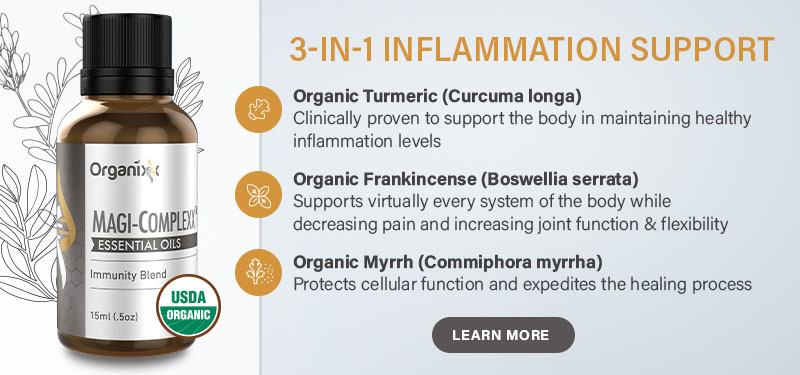
Routines. Some people live by them, some people rebel against them. The fact is that most successful, health-conscious folks stick to at least one. This is the one they do in the morning to set themselves up for a frictionless, stress-free day. For a large majority of people, part of this routine includes morning stretches.
Can you spare less than 10 minutes in the morning to get limbered up, revved up, and ready for your day? If so, read on!
The Importance of Routine
If we can convince you to commit to any kind of routine, it would be the one you do in the morning. A morning routine clears your mind. With a routine in place, you can put your energy into the important things by spending less time focusing on less important decisions each day.
For instance, former President Barack Obama’s morning routine used to include a daily choice of either a blue or gray suit.
“You’ll see I wear only gray or blue suits,” said Obama in an interview for Vanity Fair magazine in 2012. “I’m trying to pare down decisions. I don’t want to make decisions about what I’m eating or wearing, because I have too many other decisions to make [1].”
By making morning stretches part of your daily routine, you don’t need to think about it each day… and you’ll start your day off on a high note.
What Happens to Your Body and Mind by Morning
If you’re like most people, you probably wake up most mornings a little groggy with at least some amount of muscle stiffness. In addition, there may be a million annoying thoughts racing through your head… and possibly even some back pain to boot!

According to a recent survey, most Americans wake up thinking about either their finances or the tasks they must do during the day [2].
Most adults also wake up with achy joints and sore muscles.
This has more to do with physiology than psychology. When we put our bodies to rest, not only do we lie horizontally with very little movement for hours, but our body’s core temperature lowers, just as the planet does at night. Our body temps gradually decrease as the night goes on, reaching a max low point just before dawn, when the alarm clock goes off [3].
According to a 2016 study conducted by the University of Manchester in England [4], the body’s biological clock also suppresses anti-inflammatory proteins during sleep. This means that the natural pain relievers in our bodies during the day are not as prevalent when we sleep.
They are absent in the early morning as well. With our cold bodies, racing minds, sluggish blood flow, and stiff joints, no wonder most of us reach for coffee first thing in the morning.
There is another solution to the early morning blues. Starting the day by gently stretching for 5 to 10 minutes and taking a little time to calm the mind with meditation can help reduce scrambled thoughts and aching bodies.
The 9-Minute Morning Stretch
A simple search on Google will populate dozens of morning stretch routines that target different muscle groups. Have fun exploring all of them or create one that suits your individual needs.
In the meantime, we’ve compiled some of the best morning stretches to create a simple routine which will have you flexible in both mind and body, ready to start the day in no time.
#1. Mountain Pose / Time: 1 minute
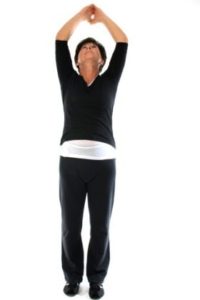 On a mat or carpet, stand with your feet flat and hip distance apart. Put your palms together in front of your chest. Take a moment to tune in to your body. Stand tall and imagine your joints completely aligned.
On a mat or carpet, stand with your feet flat and hip distance apart. Put your palms together in front of your chest. Take a moment to tune in to your body. Stand tall and imagine your joints completely aligned.
Breathe and feel the expansion and contraction of your chest and rib cage. As you exhale, release the tension in your neck and shoulders. Take 3-5 more conscious breaths.
On your next inhale, raise your hands above your head, keeping your palms together. As you exhale, try to reach the ceiling with your hands while imagining your ribcage and shoulder blades reaching for the floor.
Gaze straight ahead and take one more inhale and exhale. Slowly bring your hands down to chest level again, keeping your palms together.
#2. Raised Arms Side Bends / Time: 1 minute
Starting in Mountain Pose, raise your arms over your head again as you inhale. Next, take your right wrist in your left hand. As you exhale, bend to the left until you feel a stretch on the right side of your body.
Be sure to keep your chest open (no slouching) and your gaze forward. Stay in this position, stretching to the left side, for two more complete breath cycles. Each time you exhale, try to stretch a little more.
Slowly come up to center. Then switch sides by holding the wrist of your left arm and stretch to the right. As you stretch on both sides, pay attention to your core. Stay centered with both feet on the floor for balance. Bend your knees slightly if needed. After you have stretched on both sides, come back to Mountain Pose.
#3. Rag Doll / Time: 1 minute 
From standing, exhale as you bend slowly forward, reaching for the ground. Be sure to bend from your pelvis area, instead of your lower back, and bend your knees to bring your knees to chest as much as you need to for balance and comfort.
Hang and breath softly, allowing your upper body to simply droop while feeling a gentle hamstring stretch (the muscles on the backs of your thighs).
You can brush your fingers on the floor, clasp your hands around your elbows, or lightly place your hands on your ankles or knees. Remain inverted for 2 or 3 breaths.
Come up very slowly, imagining each vertebra becoming upright one at a time. Once upright, take one or two slow, deep breaths to center before moving on to the last stretch.
#4. Heaven and Earth Stretch / Time: 1 minute
This stretch is inspired by energy medicine master Donna Eden [5]. She herself says that Heaven and Earth may be one of the oldest stretches ever, used in tai chi and other ancient healing and martial art modalities for centuries.

Stand upright with your arms at your sides and your feet flat on the floor and slightly apart. Rub your hands together and shake them out. As you inhale, stretch one hand to the ground while the other arm reaches to the ceiling.
Flatten your palms (one should be facing “Heaven” and the other to “Earth”). As you exhale, look down at the hand that is reaching for the ground. Slowly bring both arms to center (straight out from your shoulders). Then reverse for another 2-3 breaths. This move is a great one to do outside, especially barefoot for grounding, and facing the sun as it is just coming up.
It is hard to not smile while doing this move and it can give you energy all morning long. It’s also a great one to do whenever your energy dips throughout the day or you have encountered something stressful.
#5. “Gratitude for the Day” Reflection / Time: 5 minutes
After completing the stretches, sit on your bed (on the side or cross-legged) or a chair. Expand and contract your spine from your hips slowly 3-4 times, inhaling as you expand and move forward, and exhaling as you contract.
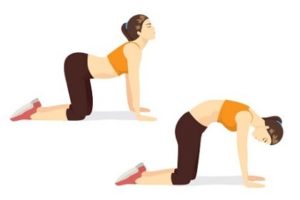
If you are familiar with the “cat/cow” stretch, this is similar, only it is done while sitting (see graphic for cat/cow movement).
Go back and forth as many times as you want, until you feel an easy stretch in your lower back. But don’t strain; take your time and go slow.
Next, close your eyes and monitor your breath. There are dozens of ways to reflect, and many involve specific breathing techniques. For this one, just observe your breath, as well as thoughts that may come in and out of your mind. The purpose of the first two minutes of this reflection is to eliminate judgement. Simply observe whatever is happening both inside and outside of you.
Finally, for the last three minutes, zero in on one thing you are grateful for as you start your day. Focus on that and imagine the gratitude for this one thing filling your heart with warm light. As you breathe in and out, imagine this light encompassing your whole being.
Dozens of studies have connected feelings of gratitude with improvements in health. For example, a 2015 study of heart disease patients, conducted at the University of California, San Diego in conjunction with the Chopra Foundation in La Costa, California, found that individuals who displayed tendencies towards gratitude and appreciation had less fatigue, were less prone to depression, slept better, and had less systemic inflammation overall [6].
Whether you are already keen on routines or would rather do without them, why not give this simple morning stretch and gratitude routine a try and see what happens. You may find that the rest of your day, and even your entire week, is better off for it!
If you’re not getting all the nutrients and antioxidants you need from food, your best source is whole food vitamins. Organixx Multi-Vita-Maxx contains 21 uniquely fermented vitamins and enzyme-activated minerals that are more “bioavailable” and easily absorbed by your body than the synthetic compounds found in most supplements.

Everyone knows that exercise is a good thing. Establishing a workout program for just 30 minutes a day, coupled with strength training two days a week [1], can provide you with many health-boosting benefits.
These workout benefits include improvement in multiple areas, including:
- Weight loss
- Diabetes
- Anxiety & Depression
- Inflammation
- Heart health
- Osteoporosis
- Cancer
- Gut health
- Sleep, Focus, and Libido
If you’ve never had the healthy habit of a workout program or you’ve recently fallen off your diet plan (or treadmill), you may not know how to get started (again). How do you stick with a workout program that is going to give you the results you want?
Read on for six tips designed to motivate you to get moving and KEEP YOU MOVING every day!
6 Tips for Creating a Healthy Workout Program That Works for You
#1. Love Yourself as You Are
You may be unhappy with your body or struggle with a physical condition that makes exercise more challenging. Whatever your situation, it’s important to establish self-worth before beginning your exercise journey.
Take out a journal or a piece of paper and write down three things that you appreciate about yourself and your body. Then copy them down on a post-it and tape them to your bathroom mirror. Put them where your workout clothes are. Stick a reminder of them by your front door. Make sure you see them throughout the day.
Why do all this before you start exercising? Because beating yourself up about the size of your calves, high blood pressure, jeans that are too tight, or a diabetes diagnosis is going to motivate you for about 5 minutes.
Starting this new and exciting chapter of your life with a clear awareness of the amazing qualities you already possess will build your confidence and make you feel good. This, in turn, will help you be more of your full-throttle, amazing, and totally awesome self as you gain energy and endurance by moving your body every day.
“It’s important that people love themselves now for who they are and not for what they want to become,” advises personal trainer Jonny Straws when asked how to stick to a workout program for the long-term [2].
#2. Visualize Success
Over two millennia ago, the philosopher Aristotle stated: “First, have a definite, clear, practical ideal; a goal, an objective. Second, have the necessary means to achieve your ends; wisdom, money, materials, and methods. Third, adjust all your means to that end [3].”
It seems that goal-setting is just something we humans do naturally, not only in fitness, but many important aspects of our lives. It is easier to start down the path if we know where we are going.
Many of us are great at making plans but can lose steam along the way. Sometimes, as the days and weeks go by, our goals may seem farther away than ever. Other times, we forget about what they were in the first place.
Consistent, intentional visualization is the missing piece when it comes to setting goals. Engaging in a visualization practice every day, even for a few minutes, helps to keep our goals fresh. It also helps us achieve our goals by adding images and emotions to what we want to accomplish.
The effectiveness of visualization is backed up by neuroscience. Every time you have a thought, you are creating specific neuropathways in the brain. Here is how it works:
When you think about something happy, you create neuropathways for happiness. When you think stressful thoughts, you create neuropathways for stress. Over 75 years ago, Canadian psychologist Dr. Donald Hebb coined the phrase, “Neurons that fire together, wire together [4].” This occurs in our brains every day based on what we are thinking.
Visualization techniques use the way the brain inherently works to help create the reality we want in the physical world. Spend just five minutes every day imagining yourself running up those flights of stairs, swimming those laps, or dancing your socks off to your favorite tune.
Then imagine yourself enjoying your strong, lean, powerful, and healthy body with as much feeling and mental imagery as you can muster. By doing this, you are creating more neuropathways for this experience and are helping turn your fitness dreams into reality!
#3. Take it Slow
 If you’re just starting a workout program, remember that you don’t have to run a marathon your first week. In fact, it will probably hurt you in the long run if you push yourself too hard in the beginning.
If you’re just starting a workout program, remember that you don’t have to run a marathon your first week. In fact, it will probably hurt you in the long run if you push yourself too hard in the beginning.
Remember that adding movement to your daily routine is a lifestyle change and you are in it for the long haul. So take it slow and gradually build up your endurance as you go along.
For example, start out with a 15-minute walk 3 times your first week and gradually increase to 20 minutes 4 times in week 2. Or dance to 1 song a day during the first week, then groove to 2 songs a day the next week.
You may also consider exploring exercise classes for the first few months of your commitment to fitness. Try one exercise class at your local gym or rec center each week until you find one you really enjoy. Then commit to going twice a week instead of just once.
Not all exercise needs to be super intense for there to be health benefits either. Did you know that stretches that gently twist the spine can have positive effects on the adrenals, thyroid, and pancreasand activate the healing hormones of the parasympathetic nervous system [5]?
#4. Make it Fun
The number one excuse people have for not exercising is because they “don’t have the time.” A recent article in Psychology Today [6] posits that there is another reason why we don’t get off the couch and put on our gym clothes: exercise is uncomfortable.
Dr. Sherry Pagoto, a licensed clinical psychologist and professor at the University of Massachusetts Medical School, explains that exercise is uncomfortable to most of us because it goes against the relative comfort which defines how most people live in the modern, industrialized world. According to Dr. Pagoto:
“We live in a society where we keep the indoor temperature adjusted to perfection all year round, wrap ourselves in soft clothing, wear thick-soled shoes to protect our feet from harm, lay on cushy beds draped in poofy covers, and shower and scrub with warm water and soap every single day. Is all of this First-World pampering making us intolerant to even mild physical discomfort?”
How many people really revel in the idea of getting blisters, sweating profusely, being out of breath, messing up their hair, and having sore muscles? Pagoto suggests getting out of our physical comfort zone as much as possible to prepare for regular exercising. Going out in the rain without an umbrella, letting yourself get dirty in nature, or stomping in a puddle so your shoes and socks get wet are good examples.
For those of us who are not as courageous, however, there is another (kinder) way to ease into a workout program that works for you and stick to it. That is to have fun!
Do you remember the last time you went to a concert and danced yourself into a sweat, but didn’t even realize it? Engaging in a physical activity that you really enjoy will increase the likelihood that you will “stick to it.”
Here are some activities that might point you in a fun direction. And, yes, they are all considered a “workout:”
- Brisk walking
- Taking a dance class
- Swimming
- Rocking out to your favorite tune
- Running with your dog
- Hiking or biking at the park or the beach
- Martial arts
- Paintball
- Indoor rock climbing
- Bouncing on a trampoline
- Watching your favorite show while you’re walking briskly on the treadmill
- Going on a “walking meeting” instead of talking in the office or a coffee shop
 The concept of strength in numbers also applies to working out. As social beings, having a workout partner or joining a class not only is more fun, it also helps us feel like we are not alone.
The concept of strength in numbers also applies to working out. As social beings, having a workout partner or joining a class not only is more fun, it also helps us feel like we are not alone.
A study published in the Journal of Social Sciences found that people are influenced by the exercise behaviors, healthy or otherwise, of others around them [7]. So if your friends and family don’t exercise, try and find a group of people who can be a positive role model for you.
#5. Work Exercise into Your Schedule
When it comes to finding the time in our busy schedules for working out, experts advise creativity and planning [8]. Remember that you don’t have to do it all at once.
Here are a few ways you can get your heart beating when you are on the run:
- Take the stairs
- Park a few blocks away
- Bike to work
- Consider a workout app for your phone or computer. Many have programs that will get you sweating in 15 minutes
- Try burst training or HIIT [9]
- Use your lunch hour to take a brisk walk or a jog
- Do squats, stretches, or other movements whenever you are on hold on the phone, waiting for dinner to cook, or even sitting in the office or in traffic
#6. Celebrate Success
Finally, keep in mind that working out doesn’t have to be all work. Experts in the field of operant conditioning (learning through positive and/or negative reinforcement) state that when individuals engage in activities that elicit positive responses or rewards, they will be more likely to repeat them.
So be sure to take the time to celebrate your successes in a healthy way whenever you reach weight loss, time frame, or other fitness goals. Book a massage, enjoy a spa day, or treat yourself to a new outfit to celebrate all the new energy, strength, and fitness you are going to experience as you get into the groove of your daily workout program.
Organixx Clean Sourced Collagens blend contains five types of collagen from four sources. What’s more, it’s combined with targeted nutrients such as zinc, vitamin C, and vitamin B6 which specifically enhance the bioavailability and potency of collagen. Clean Sourced Collagens is formulated from the ground up to enhance and support your body’s natural ability to heal and rebuild itself from the INSIDE out.

Rebounding is a type of exercise that utilizes a small trampoline (called a “mini trampoline” or “rebounder”) for low-impact exercise. Individuals can perform a wide range of movements on a rebounder, including bouncing, twists, running in place, jumping jacks, side-to-sides, and even dance moves.
Trampolining is popular in fitness circles today, and promoters list a plethora of physical benefits from regular use. But are those claims supported with actual results?
Most natural health experts and thousands of “trampers” say YES!
Rebounding is a fun way to get your daily dose of aerobic exercise, which is extremely important to maintaining long-term health. But it seems to especially benefit the lymphatic system, reducing inflammation.
The Importance of Movement for Lowering Inflammation
The lymphatic system consists of the tonsils, bone marrow, spleen, lymph nodes, and, of course, lymph (the fluid that circulates throughout the lymphatic system).
This system has a dual function:
First, it is one of the main ways that the body eliminates toxins. It does this by circulating lymph, which carries waste and other byproducts through the nodes and out of the major detoxification pathways, especially the liver.
Second, the lymphatic system helps your body fight pathogens via the immune system, since lymph carries immune system cells. Pathogens are stored in the lymph nodes until B and T white blood cells, or lymphocytes, destroy them.
Your lymphatic system sounds like a well-oiled machine, right? Well, it is except for one caveat: unlike your blood, which has the heart and other cardiovascular mechanisms to push it through your body, the lymphatic system has no pump at all!
This is where exercise, such as rebounding, comes in. Did you know that you have three times more lymph than blood running through your body at this very moment? And the only way this fluid can keep moving is if you do.
That’s right – muscular contractions take place as you exercise, and this is the only way that lymph can circulate.
You may have heard of conditions such as lymphedema, edema, and fibrosis. According to the Lymphatic Education and Research Network (LERN) [1], there are roughly 10 million Americans who suffer from lymphedema and other lymphatic diseases.
These painful and sometimes debilitating conditions are all different manifestations of the same thing: lymph that is not flowing properly through the body. Stagnant lymph inevitably leads to inflammation, which is the foundation of almost all disease.
The Health Benefits of Using a Rebounder Trampoline
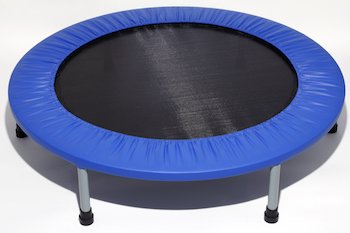 Some people suffer from genetic lymphatic deficiency conditions, while others are prone to lymphedema because of lymph node removal; up to 50% of those who get Auxiliary Lymph Node Dissection may develop lymphedema, according to National Cancer Institute statistics [2].
Some people suffer from genetic lymphatic deficiency conditions, while others are prone to lymphedema because of lymph node removal; up to 50% of those who get Auxiliary Lymph Node Dissection may develop lymphedema, according to National Cancer Institute statistics [2].
The vast majority of lymphatic conditions, however, could be prevented by simply moving the body more and making other lifestyle changes. Especially for those who have had several lymph nodes removed, regular exercise can significantly reduce symptoms.
The most renowned study showing the health benefits of rebounding was a 1980 investigation conducted by NASA and the University of Kentucky [3]. The purpose was to determine the best kinds of exercise for astronauts, who inevitably lose muscle mass while in space.
In the study, healthy male athletes ages 19-26 were instructed to run on a treadmill with intervals of rest in between. Pulse, oxygen consumption, and other factors were measured. A week later, the athletes returned to be tested using the same parameters on a trampoline.
Here are some of the discoveries researchers made:
The “magnitude of the bio-mechanical stimuli” is higher using a mini-trampoline than a treadmill. This finding led researchers to postulate that rebounding may help in determining “remedial procedures” for returning astronauts.
“The external work output at equivalent levels of oxygen uptake were significantly greater while trampolining than running” and that the “greatest difference was about 68%.” This is significant because it indicates that using a trampoline as opposed to a treadmill can give a person a solid aerobic workout and corresponding healing effects with less effort (i.e. oxygen used and demand on the heart).
Additionally, NASA researchers noted that the “biomechanical conditioning” (benefits of the workout on the body) may be twice as efficient with trampolining than running.
The study recognized how extremely low-impact rebounding is. Putting less pressure on the muscles and joints, especially the ankles, knees, and hips, allows a person to exercise at longer intervals without feeling fatigued.
A study published in 2014 found that 12 weeks of exercise with a mini-trampoline “significantly” helped elderly women with their balance [4].
Others speculate that a mini-trampoline may be particularly beneficial for those who have knee and other joint issues, including arthritis. The smaller diameter prevents how high you can jump, and also reduces the gravitational pull on your knees, reducing impact [5].
“Rebounding allows the muscles to go through the full range of motion at equal force. It helps people learn to shift their weight properly and to be aware of body positions and balance,” said Dr. James White, PhD, director of research at the physical education department at the University of California at San Diego, in an interview with Vitality Magazine [6].
In that same article, Vitality Magazine explains how rebounding can significantly help with symptoms of lymphedema through “muscle contraction, force of gravity, and internal massage,” all of which can encourage lymphatic flow.
Can Rebounding Even Help to Prevent Cancer?
Getting your lymphatic system going again through rebounding doesn’t only prevent painful symptoms in the extremities. Rebounding, along with proper hydration and a healthy lifestyle, helps to lower the risk of disease in general with its lymph-boosting, inflammation lowering, blood-cleansing, and detoxification-aiding attributes.
Besides harboring T and B lymphocytes, the lymph nodes are also a production place for Natural Killer cells [7], which specifically target cancer cells for destruction.
3 Types of Rebounder Workouts
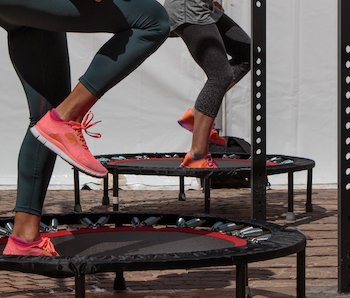 Natural healing advocate Chris Wark of Chris Beats Cancer personally used rebounding as one of his main protocols for naturally healing from colon cancer [8]. He explains three main modes of rebounder trampoline exercise:
Natural healing advocate Chris Wark of Chris Beats Cancer personally used rebounding as one of his main protocols for naturally healing from colon cancer [8]. He explains three main modes of rebounder trampoline exercise:
#1: The Health Bounce:
Lightly bounce up and down on the rebounder while leaving your feet on the mat. This is designed for those who may not be able to do more aerobic tramping, and can be done several times a day from 10 minutes up to an hour.
#2: The Strength Bounce:
This bound has one step: simply bounce as high as you safely can! It is built for strengthening muscles, improving balance, and moving lymphatic fluid.
#3: Aerobic Bounce:
You can dance, jump, twist, run, or invent your own move. Just keep up the intensity until you get your blood pumping and start to sweat.
Where Can You Rebound?
You can rebound at the gym, but most individuals purchase a mini-trampoline to use at home and/or a collapsible travel rebounder to take on the road.
Mini-trampolines are fairly inexpensive, but spending a bit more to get a premium rebounder trampoline may be worthwhile. Just be sure that your mini-tramp has enough spring to prevent jarring of the knees and other joints.
The popularity of rebounding signifies a greater understanding of the importance of the lymphatic system for overall health, boosting the immune system, lowering inflammation, and creating detoxification, energy, and vitality in the body.
It is safe to say that rebounding could rank among the top exercises for overall disease prevention. It’s official: trampolines are not just for kids anymore!
Turmeric 3D from Organixx provides you one of the most “bioavailable” forms of turmeric due to its unique fermentation process. This means your body experiences the maximum benefits of the purest, most potent turmeric available!
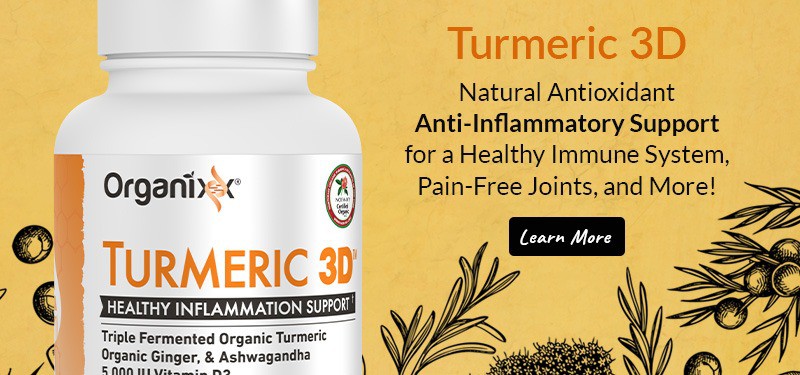
American pet owners collectively spend upwards of $63 billion per year pampering their furry loved ones, according to the American Pet Products Association (APPA). This includes a great many people who are happily willing to fork over top dollar in exchange for everything from fancy toys and plush bedding, to cute little outfits and top-notch grub.
This love of animals is fueling a burgeoning market for pet products that’s currently expanding at a rate of about four percent annually. [1]
Pet parents naturally want what’s best for their pets when it comes to their care and nourishment. That’s why the pet food market in particular has been seeing some impressive transformations. Pet owners are increasingly opting for more than just the standard kibble products of the past.
Depending on what you’re willing to spend, there are all sorts of premium, super premium, and even ultra premium pet foods on the market from which to choose. Each features a wide range of specialty ingredients and formulas.
All-natural and organic pet foods are one such segment that’s rapidly growing in popularity, along with the grain-free kibble craze. “Simple” is a popular buzzword that’s also garnering plenty of attention, as are dog and cat food formulas that contain only ingredients that are easy to identify and pronounce.
But despite all this, there’s still one key ingredient that’s often missing from even the most lavish dog and cat food products: digestive enzymes.
The Role of Digestive Enzymes for Dogs & Cats in Nutrient Absorption
Unless your cat or dog is eating a well-balanced, strict raw food diet, chances are they’re not getting very many (or even any!) enzymes in their food. It’s a widespread problem in the modern world and a particularly serious one. Especially because the primary function of enzymes is to convert larger foods into smaller nutrients that your pet’s body can use.
Consuming food without enzymes is a lot like putting fuel in a car that doesn’t have an engine and expecting it to run: it’s just not going to happen!
Pet food devoid of enzymes (which is any cooked or processed food) is energetically dead. Sure, it might make your pets happy for a little while and keep them alive, but don’t count on it to provide your furry friends with the strength and vitality they need to live long, healthy lives.
Besides the fact that their bodies aren’t designed to digest many of the ingredients, dogs and cats fed a steady and exclusive diet of conventional kibble often suffer eventual health problems. This grim reality hinges in large part upon the fact that these products are devoid of natural digestive enzymes.
That’s because when your pet isn’t getting enough enzymes, it’s also not getting enough nutrients. This creates a nutrient deficiency that, over time, can lead to chronic disease and death (as it does in humans). The only solution is to either change your pet’s diet or supplement it with the enzymes your pet needs to live a life full of health and vitality!
Why Digestive Enzymes for Dogs and Cats?
 When digestive enzymes are missing from food, a dog or cat’s body will draw from its internal stores until there’s nothing left.
When digestive enzymes are missing from food, a dog or cat’s body will draw from its internal stores until there’s nothing left.
No matter how premium a pet food product claims to be, the truth is that it’s really only as good as its enzyme content.
Remember, enzymes are the catalysts that turn crude food matter into energetic nutrition that a pet’s body can actually use to nourish itself. When enzymes are lacking, a pet’s body will attempt to fill this gap by producing its own – which isn’t sustainable.
While internal enzyme production in things like saliva and digestive acid is completely normal for pets, it isn’t a substitute for the enzymes found naturally in living foods.
Most kibble products, which are not living foods, undergo heavy processing before being bagged and stocked on store shelves, which means their enzyme content is next to nil. When pets eat this stuff, their bodies have to work overtime in order to compensate, wearing them out much more quickly than normal.
Having to produce extra digestive enzymes also places immense strain on systems like the small intestine and pancreas. Both are forced to draw all available resources to themselves in order to derive even minimal nutrition from the “dead” food they’re processing.
This not only taxes your dog or cat’s body to an enormous degree, but it further depletes their internal enzyme stores, which constitutes a recipe for a health disaster.
Digestion and Beyond: Enzymes Are the “Currency” of Life
When it comes to digestion, enzymes are categorized into three primary groupings [2]:
- Proteases for converting proteins into amino acids
- Lipases for converting fats into fatty acids and glycerol
- Amylases for breaking down carbohydrates into simple sugars
But there are also many other types of enzymes that perform functions beyond just food processing like those that support immune function, inflammation levels, detoxification, waste removal, hormone regulation, and aging.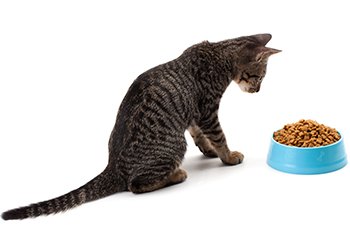
Early enzyme pioneer Dr. Edward Howell discovered back in the 1930s that enzymes are so critical to the health of both humans and animals that they are probably better categorized as nutrients.
They’re really no less important than ordinary vitamins and minerals, and enzymes deserve far more appreciation than they’re currently afforded.
Dr. Howell was also among the first to observe that enzymes function as a type of life-giving currency, with the body serving as their “bank account” for long-term storage.
Similar to how one makes cash deposits at the local bank branch, consuming enzymes in high quantities will serve to store more of them up inside the body. This is critical to the life of your pet, especially as they grow older.
Similar to how it works in humans, the aging process in pets is inversely correlated with enzyme production, meaning the older little Spot gets, the less enzymes his body is able to produce. Loading him up with enzymes as early as possible will help to give him an upper hand in life – potentially lengthening his lifespan and even helping him to maintain his lively spirit well into his older years.
It’s Never Too Late to Improve Your Pet’s Diet
Don’t fret if your furry friend is already getting up there in years, as it’s never too late to start feeding more enzyme-rich foods or supplementing their diet with living enzymes. Raw honey and bee pollen, raw dairy, and fermented vegetables are some of the most powerful enzyme-rich foods out there that will make a great addition to your pet’s diet, regardless of age.
(And remember… people are animals and need enzymes too!)
Organixx Enzyme 17 contains a whopping FIVE kinds of powerful protease enzymes in combination with one of the most advanced enzyme blends on the planet. It’s scientifically designed to help your body break down and process nutrients for better absorption, digestion, and overall health.




